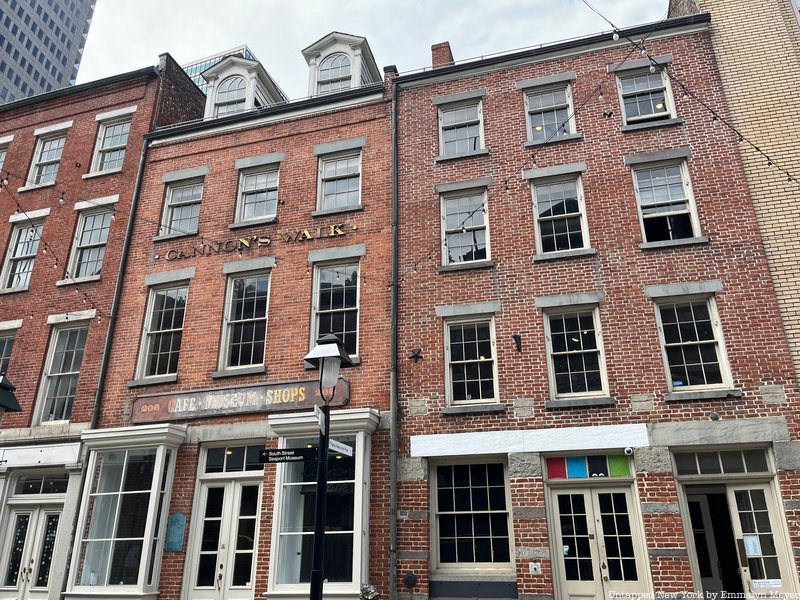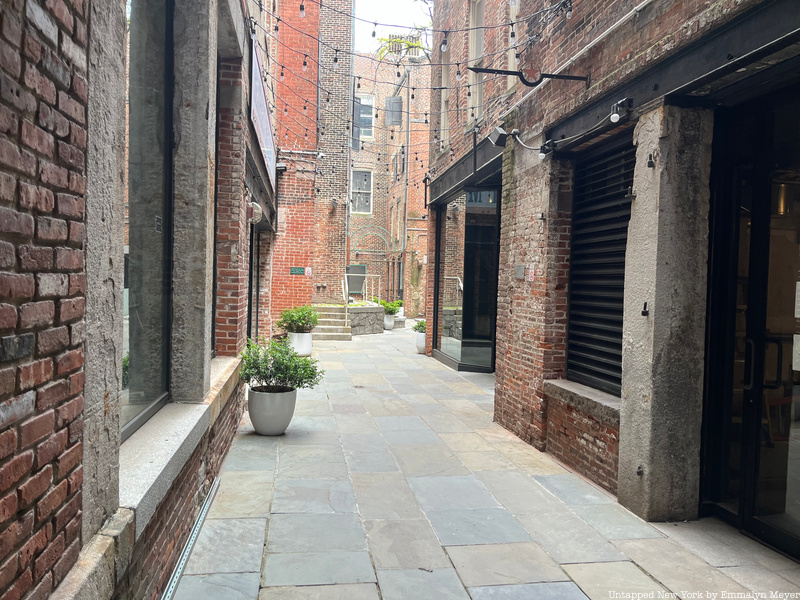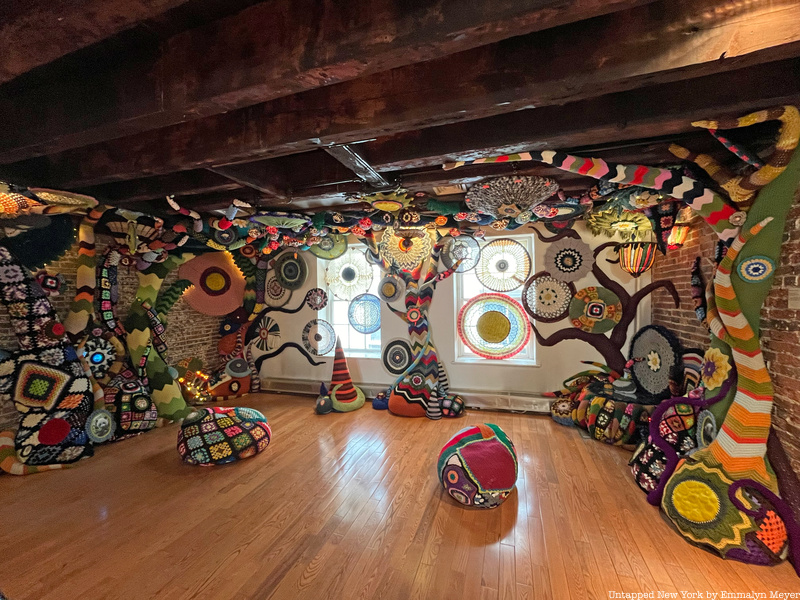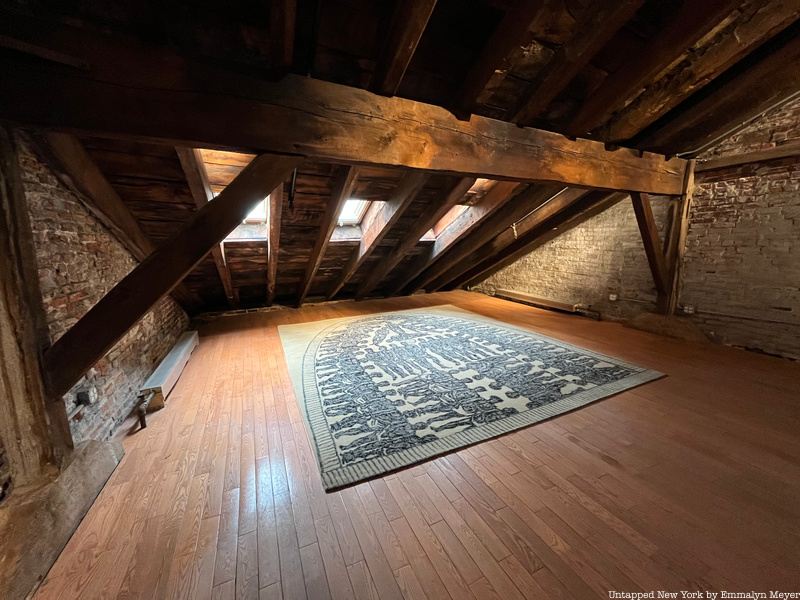NYC’s Forgotten ‘War on Christmas Trees’
Discover how an obscure holiday crackdown affects festive street vendors today!

For the first time ever, New Yorkers can step inside an 18th-century South Street Seaport warehouse and explore a new fiber art exhibition.

In the heart of South Street Seaport, New Yorkers can step inside a former 18th-century warehouse for the first time ever and explore a new fiber art exhibition. The Golden Thread incorporates legends of the seaport and old machinery left inside the historic building at 207 Front Street with innovative new textile works. On May 7th, join Untapped New York Insiders for a tour of the stunning exhibit led by curators John Lee and Karin Bravin with one of the artists featured, Orly Cogan!
This tour is free for Untapped Untapped New York Insiders! Not an Insider yet? Become a member today with promo code JOINUS and get your first month free.
When New York City was New Amsterdam, Front Street didn’t exist. The original shoreline of Manhattan met the East River at Pearl Street. As the city grew throughout the 18th century, the shoreline was extended with landfill, first to Water Street and later to Front Street. Buildings quickly sprouted against the river’s edge where maritime trade flourished.

One of the oldest extant buildings from when Front Street was the waterfront is 207 Front Street. The first building at this site was erected in 1797. It was occupied by Benjamin Stratton, Jr., a grocer and copper. By 1816, the original building was demolished or expanded (records differ), and that structure is what we see today.
The new building passed through several prominent mercantile families in New York City. Its first occupants were grocers and merchants Jonathan and Joseph Coddington. The architecture shows its mercantile function. It features a 12-foot diameter grain hoist, a peaked roof, rugged floor joists, original brick facades, and stone window trims.

Today, the building contributes to the legacy of the South Street Seaport District, standing in a cluster of historic structures bounded by Fulton, Front, Beekman, and Water Streets. In 1983, the buildings that make up this seminal block were internally connected and consolidated around a quaint, open-air courtyard known as Cannon’s Walk. This distinguishable relic of the city’s ever-evolving port was named after John Cannon and the 18th-century wharf he built along modern-day Front Street.

The Golden Thread: A Fiber Art Show occupies all four floors of 207 Front Street, calling upon the building’s former life as a textile warehouse. Over 100 artworks by 60 different artists reinvigorate the 10,000-square-foot space. Ten site-specific installations weave together radical textile transformation with stories and legends from seaport history. It is a remarkable experience to walk through a building that pulses with original character and charm and see it used for a new purpose.
As you roam the exhibition’s four floors, the artwork ranges from hanging tapestries to immersive scenes and freestanding sculptures. Gallerists and curators, Karin Bravin and John Lee, longtime New Yorkers and textile art masters, craft-fully curated an experience for visitors that highlights each artist’s mastery of everyday materials.
Works on display incorporate embroidery, stitching, quilting, sewing, and crocheting, among many other textile mediums. The exhibit resurrects these analogized “ancient” practices, juxtaposing the artists’ mastery against today’s novel understanding of them and our technology-dominated era.

Using the building’s 12-foot diameter grain hoist that originally lifted goods to the fourth floor from the East River below, artist Amanda Phingbodhipakkiya created Rest Is a Place for Wild Things. Using cotton and silk, Phingbodhipakkiya produced a canopy of lush flowers and greenery that drapes over the hoist wheel and hangs from the wooden beams of the vaulted ceiling.
Another site-specific work, Wicked Waterfront by Natalie Collette Wood, calls upon the darker side of the Seaport’s history. The work features images of ships, waves, and nautical imagery printed on ghostly thin pieces of chiffon that sway slightly. These gossamer banners represent the fading memories of seaport legends.

Other pieces in the exhibit tackle broader themes and challenges of American history, such as Willie Cole’s Original Sin created as part of the BravinLee rug program. The rug program has produced works from Louise Bourgeois, Wangechi Mutu, Jonas Wood, and more. Cole’s piece is the largest rug to date. The imagery is based upon the Brooks Slave Ship diagram that was created by the British abolitionist and publisher Thomas Clarkson in 1789.

Pulled from the exhibit’s essay, Christian Viveros-Fauné beautifully sums up the collective characteristics of the 61 international artists and artist collectives in one word: virtuosos. Every piece manifests the prowess and ambition that blossom through textile art. The story of this art medium intertwines with a treasured slice of New York’s historic waterfront at 207 Front Street, where the artists reckon with historical reflection.
The exhibit is free to visit and open to the public Tuesday to Sunday from 12 p.m. – 7 p.m. until May 12th. On May 7th, join Untapped New York Insiders for a guided tour led by curators John Lee and Karin Bravin with one of the artists featured, Orly Cogan!
Next, check out more Must-See Public Art in May
Subscribe to our newsletter